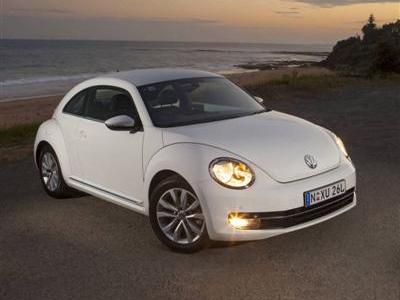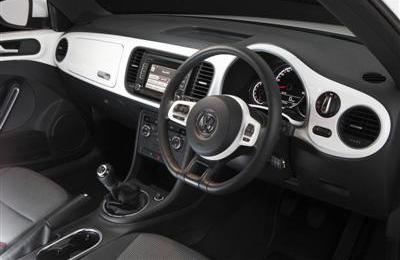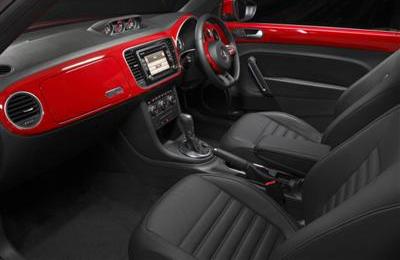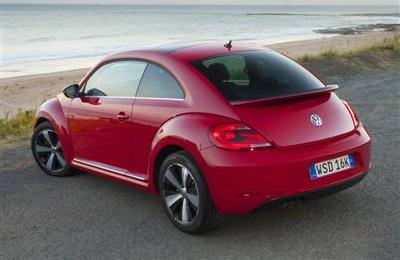|




| Volkswagen Beetle |
MLP* |
| 6-speed Manual |
$29,990* |
| 7-speed DSG |
$32,490* |
|
|
|
Volkswagen Beetle released
Home >
News >
Volkswagen
Recent new car releases ..... here
Upcoming new car releases ..... here
17th February, 2013
In its new generation, the Volkswagen Beetle, comes with a 'downsized' 1.4
litre engine and innovative features together with its heritage look to provide a modern re-make – VW claim its an icon,
re-imagined! The new model comes in one trim level and is priced from $29,990*.
The design moves away from that of the model which they called "New Beetle" (although, seemingly everyone else knew it
as the Beetle) of 1998 and instead draws on cues from the original Beetle and Beetle Ragster concept shown which was
shown at the Detroit Motor Show in 2005.
The Beetle is now longer, wider and lower. The Beetle now measures 4,278 mm in length (+149 mm), 1,808 mm in width
(+87 mm) and 1,477 in height (-21 mm). Also increased is the track width front and rear (+71 mm to 1,578 mm at the front
and +57 mm to 1,544 mm at the rear), as well as the wheelbase at 2,524 mm (+8mm).
Overseen by Walter de Silva (Volkswagen Group) and Klaus Bischoff (Volkswagen Brand), with Marc Lichte the team leader
for exterior design, the car’s new proportions mean the roof extends back further, the windscreen is shifted back and the
rear section is now more akin to that of the original Beetle.
Inside the cabin, the Beetle’s designers designed a modern, practical and distinctive appearance with easy to identify
and ergonomic controls. Certain features, such as the glovebox and colour accent panels hark back to the original Beetle.
The boot capacity is 310 litres, up from the 209 litres of the 1998 model. The Beetle has four seats, with a split-fold
rear section for added versatility. Cargo capacity is 905 litres with split/folding rear bench folded (previously 769).
In the Volkswagen tradition, a range of optional equipment is available, ranging from leather seats through satellite
navigation to Bi-Xenon headlights with LED daytime running lights.
There are also two optional packages available; Technology Package which offers Bi-Xenon headlights and LED daytime
driving lights, keyless access, electronically foldable exterior mirrors and low tyre pressure indicators, and Sports
Package which includes 18" twister alloy wheels, dark tinted rear side and rear windows, sports instruments on dash and
gearshift paddles when DSG is selected.
One economical engine will be offered in Australia; the 1.4 litre TSI twincharged petrol engine which supplies 118kW
of power and 240Nm of torque. This engine is paired with a 6-speed manual transmission as standard or with an optional
7-speed Direct Shift Gearbox (DSG).
As well as being economical and environmentally sound, the Beetle is also built to be one of the safest cars on the
road thanks not only to features such as standard ESP but also a laser welded and galvanised body structure which has one
of the highest torsional rigidity values in the segment at 26,000 Nm. This has already been recognised by Euro NCAP and
ANCAP, both awarding the new-generation VW Beetle a five-star safety rating.
However, the new Beetle has just four airbags (twin front and side/head airbags)!
Summary
• The new-generation Volkswagen Beetle made its debut at China's Shanghai Motor Show in April 2011
• Over 22.5 million Beetles have been sold since the original model of 1938, putting it among the world’s top three
most successful cars of all time; over one million of these were New Beetles, of which over 8,800 were sold in Australia
• The new generation Beetle is, like its predecessor, front-wheel drive, front engined and has three doors and four
seats
• New proportions and design break with those of the 1998 version with a longer bonnet and steeper inclined
windscreen moved back, making the latest model more akin to the 1938 original or the Ragster concept shown in Detroit in
1995
• On the road, new suspension contributes to a more dynamic driving performance than in the previous model. A very
lightweight strut type set-up at the front is completed by semi-independent rear suspension
• The Beetle is equipped with a high level of features including 17” alloy wheels, multifunction leather steering
wheel, MDI (Media Device Interface), Bluetooth and colour co-ordinated dash and door panels; dual zone climate control
air conditioning, parking sensors and power windows
• Inside, the Beetle has an all new design; the gimmicky bud vase is gone; the second glovebox integrated into the
facia with an upward folding lid (familiar to those who know the air-cooled version) is back. Ergonomic and easy to read,
all dials and controls are within easy reach and sight.
• The new model continues to be manufactured at Volkswagen’s Puebla plant in Mexico, alongside the Jetta sedan and
Golf Wagon.
Objectives and exterior
In setting their prime objective for designing the next Beetle, the team, led by Volkswagen Design Chief Walter de
Silva (Group) and Klaus Bischoff (Volkswagen Brand), was to design a ‘new original’.
The team knew that they wanted to incorporate the original Beetle’s profile more than they had with the 1998 New
Beetle, and to get back to the car’s roots. Some of the design team – young and old – actually own original Beetles and
so it is no coincidence that if you placed the original and current models side by side and illuminated their roof lines
to view their silhouettes, you would see nearly identical lines in the rear sections.
By contrast, a comparison to the 1998 New Beetle shows that nothing has remained the same. Bischoff explains: "The
Beetle is now characterised by a clean, self-confident and dominant sportiness. The car not only has a lower profile; it
is also substantially wider, the front bonnet is longer, the front windscreen is shifted further back and has a much more
swept-back angle. All of this creates a new dynamism."
While the New Beetle was defined by three semi-circles – front mudguards, rear guards, domed roof – the new model has
broken free of this geometry. The roof profile now runs distinctly lower and can be considered a continuation of the
Ragster concept car – a type of hot rod based on the New Beetle. The Beetle is now bolder, more dynamic! As mentioned,
the Beetle’s new width, height and length has resulted in entirely redesigned proportions. The gain in length meant that
the roof could be extended further, the front windscreen could be shifted back, and the rear section could follow the
contour of the original Beetle.
The new focal point is the C-pillar. In parallel, the development team increased the car’s track widths and wheelbase,
all of which gives the Beetle a powerful appearance. Despite its individuality, the car’s styling reflects elements of
the Volkswagen design 'DNA'. This is clear in the horizontal image provided by the front bumper, front air inlet,
straight lines of the bonnet edges, the precisely drawn line between the A-pillar and C-pillar and styling of the rear
lights.
All of the Beetle’s typical styling characteristics were preserved, and this should come as no surprise; after all, it
was vehicles like the Beetle, Microbus and original Golf that had a decisive influence on Volkswagen’s ‘design DNA’. Of
course, some of the Beetle’s long standing characteristics remain: these include its flared guards and the clean design
of its rear lights, the shape of the bonnet, the side and door sills and – more than ever – its ability to integrate
large wheels (up to 19 inch).
A new feature is the rear spoiler that is homogeneously integrated as standard in the design to maintain safe driving
characteristics. The top surface of the rear spoiler is always black, while its underside is painted in body colour.
Another aspect of Volkswagen’s design DNA is that the car should not only look good, but should also offer
exceptionally good functionality.
The two doors open wide, but they are not too long, making it easy to open them, even in tight parking spaces. The
Beetle is now the only Volkswagen to be equipped with round headlights. For the first time, Bi-Xenon headlights are
available as an option; mercury-free xenon gas discharge lamps with a power consumption of 25 Watts per headlight are
used for the projection module and when these are specified, daytime running lights are also included which consists of
15 LEDs arranged along the outer border of the headlight housing.
In the space where the original Beetle once had its engine, there is now a bootlid which swivels upwards – together
with the rear windscreen – when it is opened, making space for ample luggage or shopping (310 to 905 litres of cargo
capacity - depending on rear seat position).
Located on either side of the bootlid are the rear lights, which, as on all Volkswagens, exhibit an unmistakable night
look (c-shaped). The basic shape of the lights is integrated in the design of the flared rear mudguards, while the lights
themselves are fully designed in dark red – except for two small white areas for the indicator and reversing lights.
In order to allow Beetle customers to personalise their cars, eight colours will be available with this colour-coding
also transferred to the car’s interior.
Interior
In summing up his view on the interior, Klaus Bischoff, Head of Design for the Volkswagen Brand says: "My team has
achieved a noteworthy coup with the Beetle: its interior design is as unique as it is unmistakable, and very much a
Beetle design, just like the car’s exterior styling."
Its many details make the interior refreshingly unique. There is the swept-back front windscreen; the instrument panel
that combines innovative technologies and controls with painted surfaces; and a glovebox in the style of that in the
original air-cooled Beetle. The car offers ample space and comfort for four people.
As previously mentioned, there is an array of colour options available for the Beetle’s exterior which also carries
through to its interior. Candy White, Tornado Red, Saturn Yellow and Denim Blue are the standard colours. Alternatively,
the new generation Beetle can be finished in a metallic paint; Platinum Grey, Moon Rock Silver or Reflex Silver; or in
Deep Black pearl effect paint.
Every element of the interior has been redesigned, and all instruments and controls are designed to be clear, easy to
find and read and ergonomically optimised. In front of the driver, three round instruments (tachometer, speedometer, fuel
gauge) supply all of the key information and in the central speedometer dial there is a multifunction display. The
adjustable air vents and instruments have chrome bezels. This also applies to the audio/navigation systems that are
located in the driver’s visual field on the dashboard, framed by two air vents. Beneath this are the temperature control
panel, also redesigned, a central switch bar for the hazard lights and parking sensors and finally the gear shift grip
with the engine start button (applicable with Technology Package).
Like the original Beetle, the new car has an extra glovebox integrated in the front fascia designed with an upwards
folding lid (the standard glovebox that is also integrated opens downward).
A distinguishing feature of the VW Beetle is that its interior ergonomics and packaging are based on completely new
parameters. While drivers in the air-cooled Beetle travelled in a very low-slung seat, and drivers of the New Beetle felt
as if they were seated too far back, the latest Beetle offers a sporty driving position with all features and controls,
including the gear shift, intuitively in the ‘right’ place.
|
|
|

Self-Catering Holiday
Accommodation in
Denmark, WA
..... more
|
|
|
1.4-litre, TSI, 16-valve 4-cyl, 118kW
Locally, the Volkswagen Beetle will be available with one petrol engine, Volkswagen’s 1.4 litre 118kW TSI twincharged
engine. The design of the TSI powerplant results in excellent efficiency and therefore lower carbon dioxide (CO2)
emissions ensuring the Beetle complies with the relevant Euro5 emissions requirements.
This 1.4-litre TSI unit uses supercharging and turbocharging to produce an impressive 118kW at 5,800 rpm and 240 Nm of
torque at 1,500 - 4,500 rpm. It is available with a 6-speed manual gearbox or 7-speed DSG gearbox as an option. This
Beetle completes the 0 to 100 km/h sprint in a reasonable 8.3 seconds. Combined economy is 6.8 litres/100km (6.4 l/100km
for DSG), while CO2 emissions are 158 g/km (148g/km for DSG).
TSI technology
The TSI name describes all of Volkswagen’s pioneering forced-induction petrol engines. These units produce high levels
of power with low emissions and fuel consumption from a relatively small capacity. Where FSI uses the direct injection of
petrol into the combustion chamber to improve efficiency and hence reduce fuel consumption and emissions, TSI takes this
a step further and uses an FSI engine which is then either dual-charged through a combination of an engine driven
supercharger and an exhaust gas turbocharger.
Key to the TSI’s success is that direct injection allows an abnormally high compression ratio of 10:1 to be used in
conjunction with high maximum boost pressure of up to 2.5 bar absolute. This enables the relatively small engine to use
very long gearing to provide exceptional fuel efficiency for a petrol engine, particularly at motorway cruising speeds.
As a bonus, the TSI engine provides driver enjoyment, producing high power and torque across a rev range from 1,500 to
5,800 rpm.
Keyless Access
For the first time the Beetle is offered with a keyless entry, start and exit system. When one of the new design door
handles is touched, a signal is transmitted from an aerial integrated in the handle.
The system then searches for a valid ID transmitter, from which it detects access authorisation. The antenna relays
the code sent by the transmitter to the relevant control unit in the Beetle. If the code is recognised, the system then
unlocks the doors, deactivates the immobiliser and the anti-theft alarm system (option), and allows the vehicle to be
started at the push of a button. Other antenna check whether the ID transmitter is in the car. For instance, to protect
children, the Beetle cannot be started if the ID transmitter is too far away from the vehicle. It is not possible, for
example, to put the transmitter on the roof, get in the car and drive off.
If no door is opened within 30 seconds, the doors lock again as with a conventional system operated by remote control.
From inside the car, it is unlocked by pressing a button in the door handle. The Beetle can be unlocked and locked by
remote control.
Nameplate Badges
In previous generations, the Beetle has been one of the few Volkswagen models to be sold unbadged. The latest model
changes this and gives owners the option to personalise their cars – not only with a ‘Beetle’ badge, but with other names
the vehicles has been endowed with throughout its history such as ‘Bug’ or simply, ‘Volkswagen’. These badges are
available through Volkswagen Accessories.
Equipment Highlights
Volkswagen Beetle 1.4-litre TSI 118 kW 6-speed manual (optional 7-speed DSG) specification highlights are listed below:
• ABS with EBD, Brake Assist, ESP, XDL and HSA
• Driver and front passenger airbags
• Combined head and side impact airbag system for front occupants
• Driver and front passenger safety head restraints
• Front seatbelts with pre-tensioners and belt force limiters
• Three-point seatbelts and head restraints for both rear passengers
• Warning buzzer and light for front seatbelts and visual indication for rear seatbelts if unfastened
• Body-coloured bumpers and door mirror housings with integrated indicators
• Electrically heated and adjustable door mirrors
• Front electric windows
• 17x7” Rotor allow wheels (4)
• Black cloth upholstery
• Front seats with height adjustment
• Easy entry sliding seats (for access to rear seats)
• Height and reach adjustable steering column
• Front centre armrest with storage compartment
• Multifunction trip computer with visual gear change recommendation for optimum fuel consumption
• RCD510 audio system with MP3 compatible 6-disc CD player with eight speakers and AUX-in socket for connection to an
external multimedia source, e.g. iPod, MP3 player
• Lockable glovebox with secondary upwards-opening glovebox
• Split fold rear seat backrest (50:50)
• Dual zone climate control air conditioning
• Body-coloured door handles and chrome exterior trim
• Rear tailgate spoiler
• Body-coloured dash and door panels
• Interior chrome trim
• Leather trimmed three-spoke multifunction steering wheel
Volkswagen Beetle Pricing*
Beetle 6-speed Manual $29,990*
Beetle 7-speed DSG $32,490*
Options
Metallic/Pearl Effect Paint $500*
Panoramic Electric Glass Sunroof $1,700*
RNS510 Satellite Navigation System $2,500*
Vienna Leather Appointed Upholstery $3,300*
Technology Package $2,700*
Sports Package $1,800*
Anti-theft Alarm System $600*
NOTE:
* Manufacturer's List Price (MLP) excludes dealer delivery fees and the numerous statutory charges (commonly known as
on-road costs). Additionally, please note that all prices, fees and charges are subject to change without notice, as are
the specifications.
E&OE.
|